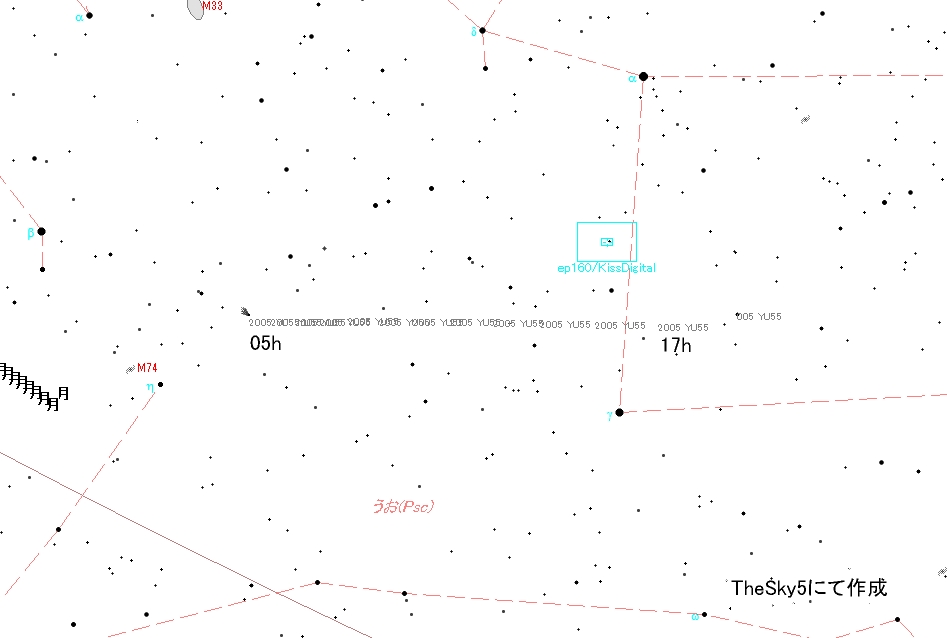|
* 地球接近小惑星2005YU55 * 2005 YU55 2005 YU55, also written as 2005 YU55, is a potentially hazardous asteroid[2] 310 meters[4] or about 400 m (1,300 feet) in diameter.[5][6] It was discovered on 28 December 2005 by Robert S. McMillan at Steward Observatory, Kitt Peak.[1] On 8 November 2011 it passed 0.85 lunar distances (324,900 kilometers; 201,900 miles)[10] from the Earth. This is the closest known approach by an asteroid with an absolute magnitude this bright since 2010 XC15 (H = 21.4) approached within 0.5 lunar distances in 1976.[3] In February 2010, 2005 YU55 was rated 1 on the Torino Scale, indicating that a pass near the Earth poses no unusual level of danger. On 19 April 2010, radar ranging by the Arecibo radio telescope reduced uncertainties about the orbit by 50%.[6] This improvement eliminated any possibility of an impact with the Earth within the next 100 years.[6] It was removed from the Sentry Risk Table on 22 April 2010 and as such it now has a rating of 0 on the Torino Scale.[11] On 8 November 2011 at 23:28 UT the asteroid passed 0.8453 LD (324,900 km; 201,900 mi) from the Earth.[10] On 9 November 2011 at 07:13 UT the asteroid passed 0.6231 LD (239,500 km; 148,800 mi) from the Moon.[12] During the close approach the asteroid reached about apparent magnitude 11,[5][13] and would have been visible to experienced observers using high-end binoculars with an objective lens of 80+ mm if it were not for bright moonlight preventing a true dark sky. Since the gibbous moon did interfere with the viewing,[3] observers trying to visually locate the asteroid required a telescope with an aperture of 6 inches (15 centimeters) or larger.[3][10] The next time a known asteroid this large will come this close to Earth will be in 2028[3] when (153814) 2001 WN5 passes 0.00166 AU (248,000 km; 154,000 mi) from the Earth.[14] According to Jay Melosh, if an asteroid the size of 2005 YU55 (~400 m across) were to hit land, it would create a crater 6.3 km (3.9 mi) across, 518 m (1,699 ft) deep and generate a seven-magnitude-equivalent-earthquake.[15] The chances of an actual collision with an asteroid like 2005 YU55 is about 1 percent in the next thousand years.[15] Study Swift captures flyby of asteroid 2005 YU55. During the 2011 passage 2005 YU55 was studied with radar using Goldstone, Arecibo, the Very Long Baseline Array, and the Green Bank Telescope.[3] The Herschel Space Observatory has made far-infrared measurements of 2005 YU55 on November 10, helping determine its temperature and composition.[16] Radar analysis has also helped to pin down the asteroid's albedo, or diffuse reflectivity. Although radar measurements do not detect visible light they can determine the distance and size of an object with a high degree of accuracy. This information, coupled with visible light measurements, provides a more accurate measure of an object's absolute magnitude, and therefore its albedo. On November 8, 2011, NASA released a statement mentioning a number of structures on the surface of the asteroid, which were detected as it passed near the Earth.[17] On November 11, 2011, higher-resolution images showed concavities, a ridge near the asteroid's equator, and numerous features interpreted as decameter-scale boulders.[7][18] Shape modeling based on the radar images shows that YU55's shape is close to spheroidal, with maximum dimensions of 360±40 m, and an equator-aligned ridge. A 150--200-meter-long, ~20-meter-high rise forms a portion of the ridge-line, and the number of boulders on the surface is comparable to that seen on the asteroid 25143 Itokawa by the Hayabusa spacecraft.[7] Optical lightcurve measurements during the flyby provided a more accurate estimate of the asteroid's spin period -- about 19.3 hours.[8] Because 2005 YU55 is so nearly spheroidal, it was not significantly torqued by Earth's tides during the flyby, and there is no evidence of non-principal-axis rotation. Optical, near-infrared,[9] and ultraviolet[19] spectroscopy confirmed that 2005 YU55 is a C-type asteroid. from |
軌道要素をJPL Small-Body Browserから星図ソフトTheSky5に取り込み検索結果を手直したデータです。11月8日は太陽のすぐ西に位置していて日本からは見られそうもありません。11月 9日 08時(日本時)に最接近(0.002207AU)します。
距離は地球からの距離で天文単位AU、赤経と赤緯の元期は 2000年です。
離角と位置角は 1時間前の位置からの移動量と方位角です。
2011/11/09 17:00:00(JST)
距離:0.003499 等級:9.6 赤経:23h54m15.8s 赤緯:+18°58'49"
方位:93°58'54" 高度:+40°21'25" 離角:03°32'24" 位置角:+86°41'
2011/11/09 18:00:00(JST)
距離:0.003758 等級:9.7 赤経:00h07m 35.6s 赤緯:+19°11'53"
方位:101°45'31" 高度:+49°58'13" 離角:03°01'44" 位置角:+85°16'
2011/11/09 19:00:00(JST)
距離:0.004030 等級:9.9 赤経:00h18m38.4s 赤緯:+19°16'19"
方位:112°58'02" 高度:+59°37'14" 離角:02°36'31" 位置角:+87°55'
2011/11/09 20:00:00(JST)
距離:0.004309 等級: 10.0 赤経:00h 28m13.3s 赤緯:+19°17'37"
方位:131°36'06" 高度:+68°26'32" 離角:02°15'39" 位置角:+89°03'
2011/11/09/21:00:00(JST)
距離:0.004594 等級:10.2 赤経:00h36m35.2s 赤緯:+19°16'39"
方位:166°09'25" 高度:+74°04'41" 離角: 01°58'27" 位置角:+90°07'
2011:11/09T22:00:00(JST)
距離:0.004885 等級:10.3 赤経:00h43m56.9s 赤緯:+19°14'03"
方位:210°00'21" 高度:+72°25'40" 離角:01°44'16" 位置角: +91°07'
2011:11/09T23:00:00(JST)
距離:0.005180 等級:10.4 赤経:00h50m28.8s 赤緯:+19°10'19"
方位:237°52'22" 高度: +64°37'25" 離角:01°32'36" 位置角:+92°02'
2011/11/10T00:00:00(JST)
距離:0.005479 等級:10.6 赤経:00h56m19.7s 赤緯:+19°05'49"
方位:253°22'59" 高度: +54°25'00" 離角:01°22'59" 位置角:+92°52'
2011/11/10/01:00:00(JST)
距離:0.005781 等級:10.7 赤経:01h01m36.5s 赤緯:+19°00'49"
方位:263°43'12" 高度: +43°21'10" 離角:01°15'03"
2011/11/10T02:00:00(JST)(JST)
距離:0.006086 等級:10.8 赤経:01h06m25.1s 赤緯:+18°55'33"
方位:271°54'27" 高度:+31°58'52" 離角: 01°08'26" 位置角:+94°13'
2011/11/10T03:00:00(JST)
距離:0.006086 等級:10.8 赤経:01h06m 25.1s 赤緯:+18°55'33"
方位:271°54'27" 高度: +31°58'52" 離角:01°08'26" 位置角:+94°13'
2011/11/10/04:00:00(JST)(JST)
距離:0.006702 等級:11.0 赤経:01h14m54.7s 赤緯:+18°44'57"
方位:286°34'00" 高度: +09°19'45" 離角:02°01'02" 位置角:+94°41'
2011/11/10T05:00:00(JST)(JST)
距離:0.007013 等級:11.1 赤経:01h18m42.0s 赤緯:+18°39'52"
方位:294°19'10" 高度: -01°32'34" 離角:00°54'03" 位置角:+95°14'

予報よりも東を進み観測できませんでした。
「彗星・小惑星目録」に戻る 「217P(2009) F3 リニア 彗星」に戻る 「81P ヴィルト第2 彗星」に進む